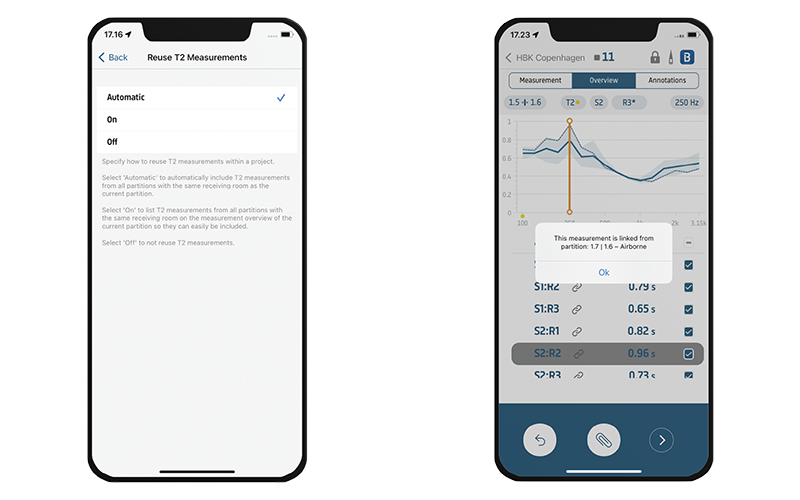It’s rare to travel to a building site to measure the sound insulation of just a single partition. Much more often, a representative sample of a range of partition types in a building must be measured, and many consultants will measure 15 or more partitions in a single day. When measuring with fixed microphone positions, this can add up to over 400 individual measurements. Naturally, methods to reduce the total number of measurements while maintaining compliance with the relevant standards are popular with busy consultants. One such method is the use of manual scanning for level measurements.
Another method, reusing measurements between partitions, is the focus of this article.
The most common situation where measurements are reused, is when testing multiple partitions with a common receiving room. In this situation, reverberation time (T2) measurements are ideal for reuse since it’s extremely unlikely that new absorption will be installed in the room during your survey. We can safely assume that the reverberation time will not have changed between tests, so there is no need to measure it again. Background sound (B2) measurements in the receiving room can also be reused, but some caution should be taken. The B2 measurement should be representative of the background sounds occurring during your receiving room level (L2) measurements. If the background sound levels on site vary throughout your survey, it’s safest to remeasure B2 for each partition close to when you measure L2.
Measurement reuse is also possible when testing multiple partitions with a common source room.
Here, the source room level (L1) measurements in the source room can be reused, but this can become a little complicated to manage when measuring according to ISO 16283, where all L1 and L2 positions must be measured for each source position before moving the source. The potential time savings or reusing L1 measurements are much smaller than those for reusing reverberation time measurements, so it is normally preferred to plan a survey with common receiving rooms instead of common source rooms.
Building Acoustics Partner makes measurement reuse safe and easy. Airborne and impact sound insulation tests are defined within a project as the adjacency of a pair of defined rooms (one designated as the source room, the other as the receiving room). Façade sound insulation tests are a little different, and only have a defined receiving room. This modelling allows the application to automatically determine where partitions share a common room, where measurements may potentially be reused. For L1, B2 and T2 measurements, there are three modes for reuse: Automatic, On and Off.
When measurement reuse is set to Automatic for a measurement type, any measurements of that type will be automatically imported into every partition where they can be reused. The measurements will be included in sound insulation calculations, and if you are running the app in guided mode, you will not be prompted to remeasure them. By default, we set measurement reuse to Automatic for T2 measurements.
The On setting is a little bit different. In this setting, potentially reusable measurements are imported into every relevant partition, but they are excluded from calculations by default. This can serve as a prompt to consider whether reusing the measurement is appropriate at the time. By default, we set measurement reuse to On for B2 measurements.

The Off setting disables measurement reuse for that measurement type. When reuse is set to Off, measurements from one partition are not imported into other partitions for any shared rooms.
By default, we set measurement reuse to Off for L1 measurements, but it can be enabled if you have a situation where it is desirable. Reuse for L2 measurements is always disabled, and there is no user setting to turn it on.
Regardless of the measurement reuse settings used in Building Acoustics Partner, the user is still in full control. Even if Automatic reuse is enabled, you can always mark the reused measurement as excluded, and add a new measurement in its place. Furthermore, reused measurements are clearly identified in the app, with a reference to the partition for which they were originally measured.


